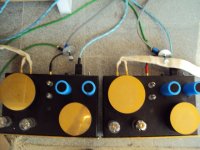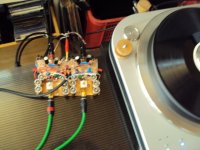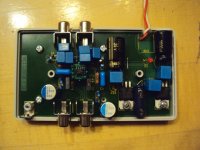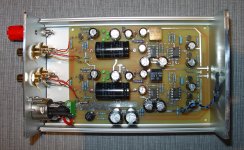Masag has now build my JG-Self linestage in 3D and after some oscilation problems got it working. He is very happy with the result. I ordered a set of PCBs too and will build it to compare it to my "open air" version.
My MPP thread was a bit quiet for a while because i am busy to set up a new company.
Nevertheless i did some work. I build two circuits based on my new input stages. One is a transimpedance circuit i have shown here in principle recently and one is a transconductance circuit with cascoded Fets. I did not try my idea yet with a reversed bipolar-Fet cascode but i got the Fets that Onvinyl recommended. Anyway, besides the input arangement they are similar. I use the current output to feed a transimpedance RIAA and then i have my Fet-BJT buffer so i boiled down the topology to a high gain inputstage, the transconductance RIAA and the buffer. This simplicity brings a sound that is very transparent and dynamic. What surprised me a bit was that they sounded very similiar dispite the totally different input stage. I also used very different PSU´s. Whereas the transimpedance stage uses a simple LM317/LM319 mono regulator the transconductance stage had the benefit of double mono LC Audio Low Noise Supplies with coil upgrade. I expected a much bigger audible difference but whatever i played, i could not make up my mind what i liked better. Until now i had no probem to differenciate the progessing circuits and usually with the notable exeption of the discrete INA i heard new details in more recent developments. Now it seemed i had hit a concrete wall. Could it be that my recent phono circuits surpassed the quality of the rest of my system ? Most of the time i am using now my JG-Self linestage to test the phono modules and i use the same turntable without any change. My first idea was to try to adjust my turntable to better performance and after some experimenting with VTA and downpreasure i decided on a slightly lower tracking force. That gave some improvement in the treble. I had the feeling that it did sound less compressed and better resolved. Maybe the cartridge got a little softer over time. Still i was not totally satisfied. The JG-Self is a mighty fine component but i simply do not need the high gain it provides so i rebuild my Veleman Tube Preamp to an Aikido Buffer. Inserted into the system it sounded a bit more liquid but also a toutch less precise. Music listening with this combination was a lot of fun for some time but it ocured to me that i need something even more transparent to get the full measure of the new phono modules. Following the path of less is more i build a kind of passive preamp. In fact it is just a good 10kOhm potmeter very close to the poweramps. I directly soldered as much as posible and did a piggyback to the active subwoofer. The sonic result was a full success. What i realised first was that the bass region was louder and better defined so i had to readjust the active crossover to the woofer a bit down in volume. The next surprise was the handling of the treble in terms of tonal colour. So far i could judge the treble performance in terms of quality and words like resolution, extention, airyness etc. come to mind. With the potmeters the treble was simply "there" but i am hard pressed to describe it. The music is simpy existing in time and space and the attention is now on the ebb and flow of the procedings. My wife was working in the other room and she is a fan of good music but rarely commends on the sound quality. Usually she says : It always sound good on your system and that was so 20 years ago. This time she was exited and was yelling " You play wonderfull music". It was Luis Armstrong and Duke Ellington with "Dukes Place", a recording on Roulette from the 60th. Yes Luis was standing 3 meters before me and Duke was playing in the backround. I was not in the mood to judge my system, i just let it play. The photos show the amps with potmeter and the new AIOG transimpedance phonostage straight over a 5m long video cable into the amps.
My MPP thread was a bit quiet for a while because i am busy to set up a new company.
Nevertheless i did some work. I build two circuits based on my new input stages. One is a transimpedance circuit i have shown here in principle recently and one is a transconductance circuit with cascoded Fets. I did not try my idea yet with a reversed bipolar-Fet cascode but i got the Fets that Onvinyl recommended. Anyway, besides the input arangement they are similar. I use the current output to feed a transimpedance RIAA and then i have my Fet-BJT buffer so i boiled down the topology to a high gain inputstage, the transconductance RIAA and the buffer. This simplicity brings a sound that is very transparent and dynamic. What surprised me a bit was that they sounded very similiar dispite the totally different input stage. I also used very different PSU´s. Whereas the transimpedance stage uses a simple LM317/LM319 mono regulator the transconductance stage had the benefit of double mono LC Audio Low Noise Supplies with coil upgrade. I expected a much bigger audible difference but whatever i played, i could not make up my mind what i liked better. Until now i had no probem to differenciate the progessing circuits and usually with the notable exeption of the discrete INA i heard new details in more recent developments. Now it seemed i had hit a concrete wall. Could it be that my recent phono circuits surpassed the quality of the rest of my system ? Most of the time i am using now my JG-Self linestage to test the phono modules and i use the same turntable without any change. My first idea was to try to adjust my turntable to better performance and after some experimenting with VTA and downpreasure i decided on a slightly lower tracking force. That gave some improvement in the treble. I had the feeling that it did sound less compressed and better resolved. Maybe the cartridge got a little softer over time. Still i was not totally satisfied. The JG-Self is a mighty fine component but i simply do not need the high gain it provides so i rebuild my Veleman Tube Preamp to an Aikido Buffer. Inserted into the system it sounded a bit more liquid but also a toutch less precise. Music listening with this combination was a lot of fun for some time but it ocured to me that i need something even more transparent to get the full measure of the new phono modules. Following the path of less is more i build a kind of passive preamp. In fact it is just a good 10kOhm potmeter very close to the poweramps. I directly soldered as much as posible and did a piggyback to the active subwoofer. The sonic result was a full success. What i realised first was that the bass region was louder and better defined so i had to readjust the active crossover to the woofer a bit down in volume. The next surprise was the handling of the treble in terms of tonal colour. So far i could judge the treble performance in terms of quality and words like resolution, extention, airyness etc. come to mind. With the potmeters the treble was simply "there" but i am hard pressed to describe it. The music is simpy existing in time and space and the attention is now on the ebb and flow of the procedings. My wife was working in the other room and she is a fan of good music but rarely commends on the sound quality. Usually she says : It always sound good on your system and that was so 20 years ago. This time she was exited and was yelling " You play wonderfull music". It was Luis Armstrong and Duke Ellington with "Dukes Place", a recording on Roulette from the 60th. Yes Luis was standing 3 meters before me and Duke was playing in the backround. I was not in the mood to judge my system, i just let it play. The photos show the amps with potmeter and the new AIOG transimpedance phonostage straight over a 5m long video cable into the amps.
Attachments
Hello Joachim, nice ideas as always. Maybe using a blocking capacitor of sufficient quality is something to evaluate against a high tracking servo also. Now that you mentioned dynamic range, Scott and I we have run a couple of FFT in another thread so to see what goes on with records. Scott run an orchestral tutti from a Chicago Symphony RCA half speed pressing, me I used the HFNRR test disc. Of course there is detailed discussion in Vogel's book, but it will be nice if you find the time at a point to run a couple of SNR with the TT playing a tone, also just dragging on a lead out or locked non modulated groove showing residual noise floor, and tell us what you find too, since you got very dynamic LNA head amps, very good TT, and you know measuring.
Hi Salas ! i will do that. Vogel gives dynamic range on a DMM pressing as 72dB and what i see in your measurements looks very similiar over a certain range of frequencies. It has been said before but we humans can hear around -30dB into the noise, so subjectivly the Vinyl Record can sound very dynamic.
For Onyinyl, here is my latest circuit. Having made the Discrete INA with balanced inputs i am now working exclusivly on AIOG ( all in one go ) solutions. The topology is a high gain input stage, eather Transimpedance or Transconductance, then a filter circuit that transfers current into voltage and then a high speed, low distortion Buffer.
I am using this circuit with under +-10V because higher voltages cause too much offset but i am thinking about some kind of DC management. Right now i use the coupling cap in my Power Amp. I see no reason why this circuit could not be run on more voltage. What i whould like to do is using 8 Fets for even lower noise and distortion and then do a +-16V supply. The Fets whould run then on 3.15V to avoid hot spots and the bipolar cascodes on 10V to avoid avalance noise at higher voltage.
For Onyinyl, here is my latest circuit. Having made the Discrete INA with balanced inputs i am now working exclusivly on AIOG ( all in one go ) solutions. The topology is a high gain input stage, eather Transimpedance or Transconductance, then a filter circuit that transfers current into voltage and then a high speed, low distortion Buffer.
I am using this circuit with under +-10V because higher voltages cause too much offset but i am thinking about some kind of DC management. Right now i use the coupling cap in my Power Amp. I see no reason why this circuit could not be run on more voltage. What i whould like to do is using 8 Fets for even lower noise and distortion and then do a +-16V supply. The Fets whould run then on 3.15V to avoid hot spots and the bipolar cascodes on 10V to avoid avalance noise at higher voltage.
Attachments
I build another USAIOG. This time i beefed up the PSU and used the best parts i could find. The OP is an LME49990 that is the best low noise chip at the moment to my knowlage. I am using Panasonic FM and Nichicon organic elcaps and precission Dale and Beyschlag resistors for the RIAA. The caps in the RIAA are 1% silver Mica and Röderstein MKPs plus Rifa PPS SMD parts. You may ask, why this hustle for a simple, little phonostage. Well, my plan is to have something that i can cary around together with my very lightweight Rega turntable. I found a very interesting SMD double Opamp that works well on low voltage and can swing 200mA nearly rail to rail with low distortion so the Poketphono ( how i will call it from now) will also include a high quality Headphone amp. That will anable me to listen to vinyl on my travels for example to check the quality of used records i plan to buy. The headphone will be a Sennheiser PX200 that i like much.
Make no mistake, this Poketphono is not a toy. Frank Schröder ( yes, the one that makes the famous Schröder arm ) is using a beefed up version that has some modifications for on situ monitoring.
P.S. i am using Caddock MK132, 1KOhm for loading.
P.P.S. i will unvaile the super compact headphone amp tomorrow.
Make no mistake, this Poketphono is not a toy. Frank Schröder ( yes, the one that makes the famous Schröder arm ) is using a beefed up version that has some modifications for on situ monitoring.
P.S. i am using Caddock MK132, 1KOhm for loading.
P.P.S. i will unvaile the super compact headphone amp tomorrow.
Attachments
They hold tight toterances, no problem. I do the 16nF out of 3 10nF series-parallel plus one RIFA PPS 1nF anyway, so tolerances average out. I think Röderstein ( or Vishey that is ) did a good job. Close tolerance parts for analog fiters got very rare these day and i am not totally convinced of Teflons because my high speed layouts really can go into trouble.
C0Gs reminded me of mica softness but cleaner, in the treble part if you ever get some, they are 10% though and takes some selection. PPS I like too, reminds me of polycarb. Warm. Teflons are best IMHO. Very expensive and big for layout and hurts to lose some in matching though. Styroflex, don't know, squeaky clean but cold somehow.
I got some 1nF COG-NPOs and will try them. Many years ago i used ceramic caps even in speakers with success.
Sonics speakers made in the USA use Teflon caps in some places.
For my MPL i use mixed dielectric. I combine 3 diffent caps with different make and value.
I needed month to find out what works best.
Well, i do not use Styroflex much any more. The ones you can get do not seen as good as they used to be. Sometimes i buy surplus at Oppermann.
What is also really good are old Röderstein KP. I think they can compete with Teflon in many ways.
Sonics speakers made in the USA use Teflon caps in some places.
For my MPL i use mixed dielectric. I combine 3 diffent caps with different make and value.
I needed month to find out what works best.
Well, i do not use Styroflex much any more. The ones you can get do not seen as good as they used to be. Sometimes i buy surplus at Oppermann.
What is also really good are old Röderstein KP. I think they can compete with Teflon in many ways.
Speakers are different as you know, there we try balance the driver and enclosure colorations / diffraction with some tonal accentuations in parts so they come across ''human'' especially in voice tests. BBC got that right first.
The caps tend to resonate more with speaker level voltages and shakes, behave differently. In low efficiency they tend to hide more though. I don't think that an Epos single HF Bennic could pass in your MPL for instance.
The caps tend to resonate more with speaker level voltages and shakes, behave differently. In low efficiency they tend to hide more though. I don't think that an Epos single HF Bennic could pass in your MPL for instance.
Yes, in speakers they see much more current and vibration. Anyway, everybody has to come up with his own recipe. I am always amaized how many people ask me what parts i use. Leaves me speechless some times.
I found like many others before me that it is a delicate ballance, a bit like cooking or playing the guitar if you wish. I am especially searcing for parts that are made now and that are available, does not work always though so i am buying what i can afford, especially P-Channel Fets at the moment. My friend Jürgen Ultee had to buy 15.000 coil formers for his inductive RIAA recently because Epcos stopped to make audio cores recently in the size he needs for his "Grail". It´s all over 100kHz at the moment. This world is getting faster and faster and that makes vinyl so attractive i think.
I found like many others before me that it is a delicate ballance, a bit like cooking or playing the guitar if you wish. I am especially searcing for parts that are made now and that are available, does not work always though so i am buying what i can afford, especially P-Channel Fets at the moment. My friend Jürgen Ultee had to buy 15.000 coil formers for his inductive RIAA recently because Epcos stopped to make audio cores recently in the size he needs for his "Grail". It´s all over 100kHz at the moment. This world is getting faster and faster and that makes vinyl so attractive i think.
In my version i still use 2200uF. Frank Schröder uses 4400uF and told me that the bass improved. I did not include the infamous Neumann pole in my version. Frank says that voices are projected foward ca. 1m when he engages the Neumann pole.
In my version i use bigger Elcaps in the supply. 1000uF FM bypassed with 0.1uF Röderstein MKP. Version 2.0 had 470uF FC bypassed with 1uF Wima MKT.
In my version i use bigger Elcaps in the supply. 1000uF FM bypassed with 0.1uF Röderstein MKP. Version 2.0 had 470uF FC bypassed with 1uF Wima MKT.
I built the 2SK369 folded cascode / OPA637 design I posted early on in this thread. The capacitors are NOS Epcos MKV (PP-in-oil) and styroflex for RIAA, and one loop-enclosed Silmic for coupling.
Not much time yet for listening, but what I heard so far is very very good, with the cleanest treble I ever experienced from LP. Noise is also very low.
Not much time yet for listening, but what I heard so far is very very good, with the cleanest treble I ever experienced from LP. Noise is also very low.



